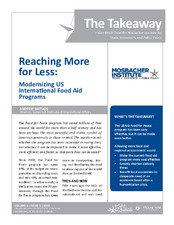| dc.creator | Natsios, Andrew | |
| dc.date.accessioned | 2015-02-06T15:18:20Z | |
| dc.date.available | 2015-02-06T15:18:20Z | |
| dc.date.issued | 2015-01 | |
| dc.identifier.uri | https://hdl.handle.net/1969.1/153687 | |
| dc.description.abstract | The Food for Peace program has saved millions of lives around the world for more than a half century and has been perhaps the most powerful and visible symbol of American generosity to those in need. The question is not whether the program has been successful in saving lives, but whether it can be improved to make it more effective, more efficient, and faster, so that more lives can be saved? The author, Director of the Scowcroft Institute of International Affairs and a former USAID administrator, makes the case that the program should have more flexibility to procure emergency food relief locally and regionally. | en |
| dc.language.iso | en_US | |
| dc.publisher | Mosbacher Institute for Trade, Economics & Public Policy | |
| dc.relation.ispartofseries | Volume 6;Issue 1 | |
| dc.subject | international food aid | en |
| dc.subject | USAID | en |
| dc.subject | Food for Peace | en |
| dc.subject | food aid reform | en |
| dc.subject | local regional procurement | en |
| dc.title | Reaching More for Less: Modernizing US International Food Aid Programs | en |
| dc.type | Article | en |
| dc.contributor.sponsor | Bush School of Government and Public Service | |


